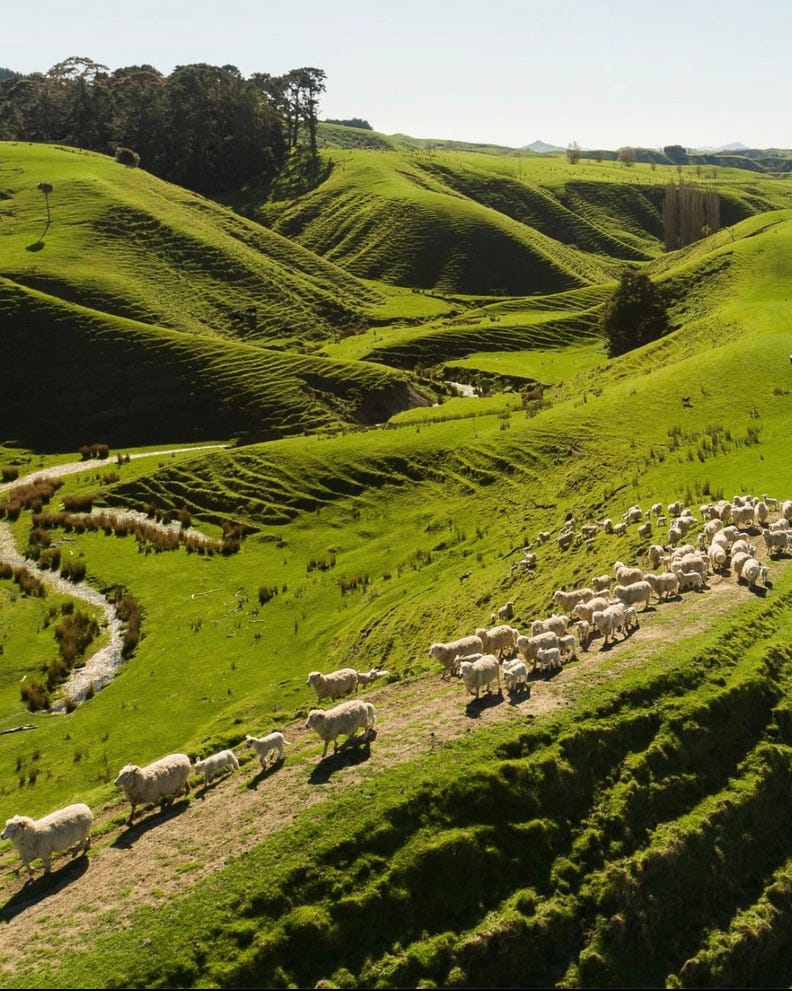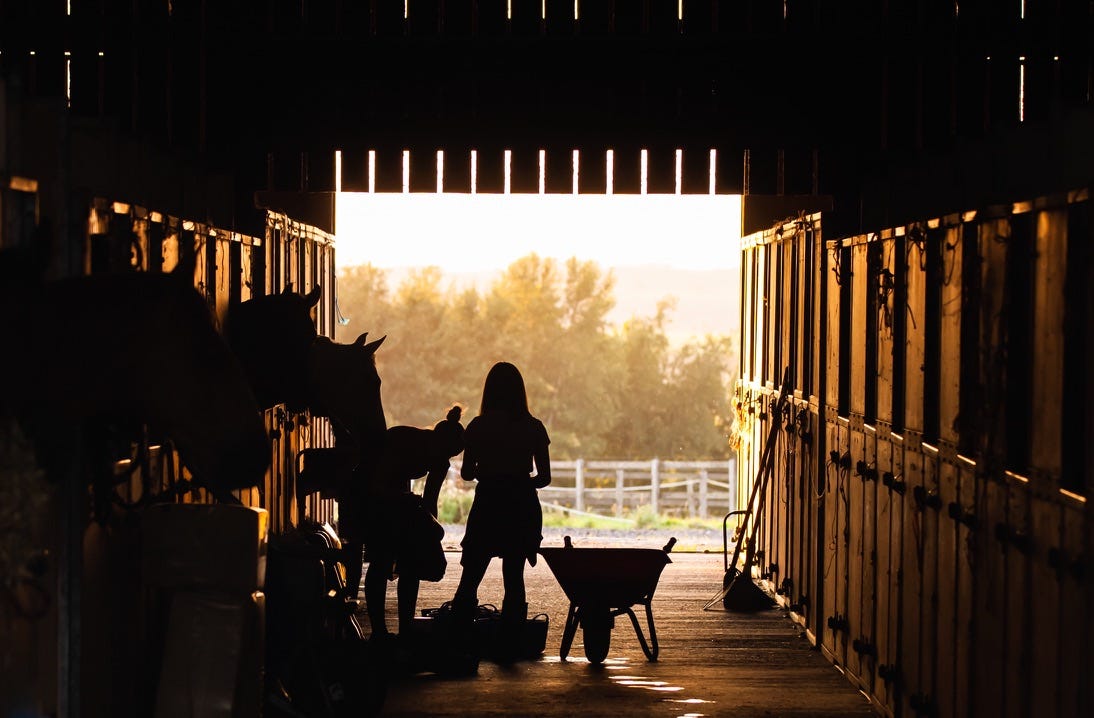Small farms are the future
On the economics of buying food from grocery stores vs. direct from farms
It’s springtime, and you know what that means — the farmer’s markets are finally open again.
Now you might wonder why it’s worth the effort to drive all that way to shop at a local farm, when you could just stop by one of the numerous grocery stores near you.
Stores often cheaper, more convenient, and you can still get organic food at Whole Foods, right?
Perhaps, but all that comes with a cost.
Aside from the obvious nutritional and environmental benefits of locally sourced, organic and regenerative food, food at a grocery store is exceedingly value destructive, as we will describe.
And doing so might just be the key to enable a future of raw milk and pastured eggs, as opposed to seed oils and fake meat.

Where does your money go?
When you spend $5 for a gallon of milk at Whole Foods, where does your money go?
You might think you’re paying the dairy farmer, but you’d be wrong.
This money has to pass through the sieve of grocery grifters, as follows:
About $1.75 goes to the store (i.e. Middleman in Chief, Jeff Bezos).
Another $.35 to the distributor (the middlemen for the middlemen, who ship your food from producer to store).
Then the dairy processor gets their cut, about $1.20, since exceedingly few farms bottle and sell their milk directly (this is in part due to the legally enforced pasteurization monopoly).
After filling their purses at the noble farmer’s expense, there is about $1.70 left.
That’s only 33% of the money you spent.
And for what? Filing TPS reports, boiling the nutrients out of the milk, and blasting maddening pop music as you wander through the seed oil saturated aisles?
Are you funding the world you want?
You like the farmer— he grows nutrient-dense, delicious food and takes care of the soil.
But the other guys? You don’t want to enrich them. That $3.35 tax is purely value extractive, contributing little benefit to the process, and funneling money from the farmer with good intentions to the less-than-magnanimous middlemen.
Who limits the amount of eggs you can buy at once? Who encourages seed oils and fake meat? Who props up the unnatural fake food system, poisoning you and your fellow countrymen?
The middlemen of the industrial food apparatus as a whole, of course. Making off with 67% of every dollar you spend at the food stores.
If there is ever a future where seed oils and fake meat are the primary foods consumed, it will come from these companies that we’ve spent 67% of our food budget on for the past 70 years.
And because consumers only want to spend so much for food, price compression at the farm level encourages, or even forces, farmers to deploy intensive cost cutting methods that reduce quality in order to stay competitive.
These are the exact methods that everyone in the health space warns you about: pesticides, fertilizers, GMOs, feed lots, anti-biotics, etc.
This system and its incentives influence more than 90% of the food that is bought and sold in the US. And it’s that system that keeps everyone pale and sick.
Want to fix it? Cut out the middlemen, and give your money to the farmer instead.
Cut out the middlemen
When you buy directly from a small, quality farm, your $5 goes straight to the farmer, less the few percent transaction fee that the banks might collect (bitcoin, anyone?).
No wasted money— the farmer is paid the full amount for his hard work, and has more money to spend on making the food higher quality.
By keeping that 67% for themselves, small farms can focus on what they do best: growing nutrient dense food that tastes amazing and improves the land, soil, and environment.
Sounds like a win-win.
However, there is a slight problem here— food is often more expensive direct from the farm.
This is confusing. If the middlemen are cut out, why do you have to pay more?
The costs of small farms
There are a few reasons why food from your local, organic/regenerative farm costs more:
Cost of quality
I don’t think it’s controversial to say around here that small farms have better quality food, and that quality is worth paying for.
When under pressure of Whole Foods, costs are the only thing that matters. If another producer can make a similar product for less, they win.
They aren’t measuring vitamin A content of beef fat, or the impact farming has on the soil.
If it looks like beef and checks the boxes, then it’s fine, whatever sketchiness is happening behind the scenes.
Thus farmers spend less time with their animals, squeeze more into the same pasture, feed them cheaper feed, etc.
So small farms that sell direct often have much higher quality than Whole Foods would even allow, because the food costs that much more to produce.
Not all local farms are equal
An unfortunate aside is that there are many farms that are small in size, but don’t produce particularly high quality food.
They use pesticides, cheap fertilizers, etc. They’ll never command the prices that their quality neighbors can. And they won’t be cheap enough for Whole Foods.
These farms either need to focus on quality, or they will eventually get swallowed up by big producers (as has been happening for 90 years).
Cost of scale
When the cost of your tractor is spread out over 100,000 acres of crops, it becomes a minimal expense per unit of food sold.
For a small farm of 1,000 acres, the same tractor would cost much more in relation to the food you grow.
And so, the food at the small farm is more expensive.
This is called “economies of scale”: the bigger you are, the cheaper each unit you sell becomes.
It sounds like all farms, and businesses in general, would just get as big as possible, and this is exactly why all the companies, whether they are food conglomerates or banks, just keep growing and growing.
However, there is an antidote to scale, and that is quality.
Small farms will never compete on price. But they can make much better food, as described above. And people are willing to pay more for better.
Grass fed, pasture raised, regenerative, biodynamic, hand-milked, etc. etc. are all things small farms can do that big ones can’t.
And many people find that to be worth paying for.
After all, we’re not “supporting” local farms out of some half-baked sense of charity to preserve a bygone era.
We should be happy to spend more at local, quality farms that have the best product.
And if they can sell less food for more money, they can compensate for their lack of scale.
But that “if” is somewhat tenuous for many of these farms, which is why they are often more expensive than necessary…
Cost of waste
When a farmer sells milk wholesale, the Land O’ Lakes truck comes around every two days to pick up the milk. All of it.
Even though the farmer only makes $1.70 per gallon, he sells every gallon he makes.
The lack of losses is quite attractive, since a farmer selling direct can’t predict when the flood of Tan Land subscribers will come calling (there just aren’t enough of us… yet).
If people don’t show up, whether at the farm stand or the farmers market, they don’t make money, no matter how much good food they’ve grown.
And if they don’t sell, especially for perishable products, then the farmer has wasted product.
And that wasted product is factored into the price that you pay.
You basically pay for two gallons of milk, even if you only bought one, since the other goes to waste.
So farmers often opt in to the grocery grift because it means guaranteed revenue, even if that revenue is smaller.
Where we are
A brief summary so far:
Grocery stores take 67% of the price you pay for food away from the farmer, its rightful recipient
We want to buy food directly from farms, to cut out the middlemen
Even still, farm food is expensive, because they often can’t find enough customers directly.
Therefore, we need to get more people to buy from their local farms if we want to extricate ourselves from the grocery grift.
Fixing this
I personally know a farmer in upstate NY who is about to send 100 lambs to slaughter. Regenerative, grass fed, pasture raised, you name it— the man rides around his farm on a horse for crying out loud.
Yet he doesn’t have enough buyers for his lamb because people don’t know about it, or they can’t get to the farm.
It’s a marketing problem. Lack of awareness leads to inefficiencies like these that lead to high prices and unstable income for farms.
And since he’s too busy growing amazing food to spend time marketing, no one knows about his farm.
Meanwhile, there are thousands of people who lament their inability to find food of this caliber.
If only the customer and farmer could find each other, all our problems would be solved…
Connecting farms and eaters
It’s not as hard as it might seem.
I’ve put together a database of 2000 local, high quality farms in the US. And you may even find some that deliver.
It’s not perfect, but it’s a start. Check it out here, and let me know what you think.

Remember, the more people that buy from farms, the better for everyone (financially).
P.S., if you live anywhere between the NYC metro area and the Adirondacks, send me an email and I’ll connect you with the aformentioned lamb farmer. He can likely arrange for drop off depending on where you live.






In regards to the farmer in upstate NY and his lambs, is he familiar with Butcher Box? He is just the type of farmer / quality livestock that they use. https://www.butcherbox.com/sourcing/